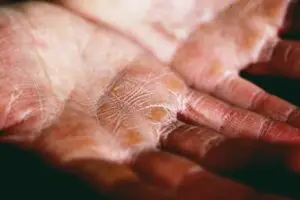Page Contents
As we age, our skin undergoes several changes, making older adults more susceptible to various skin conditions, including dermatitis. Dermatitis, commonly known as eczema, refers to inflammation of the skin that results in redness, itching, and sometimes blistering or peeling. While dermatitis can affect individuals of all ages, it presents unique challenges in the elderly due to the natural ageing process of the skin. Understanding the causes, types, symptoms, and treatment options can help caregivers and healthcare providers better manage dermatitis in older adults.
The ageing skin and its vulnerability
As individuals age, their skin becomes thinner, less elastic, and more prone to dryness. These changes occur due to reduced collagen production, slower skin cell regeneration, and diminished oil gland activity. Ageing skin also tends to have a weaker skin barrier function, meaning it can no longer retain moisture effectively and is more prone to irritants and allergens. This increased vulnerability makes older adults more susceptible to dermatitis and other skin-related issues.
Additionally, the immune response in older individuals is often weakened, making it harder for their skin to recover from inflammation or infection. These age-related changes, combined with the potential use of multiple medications and the presence of chronic illnesses, further complicate the skin’s ability to repair itself after damage.
Common types of dermatitis in older adults
Several types of dermatitis can affect older adults, each with distinct causes and presentations:
- Atopic dermatitis
Although more common in children, atopic dermatitis can persist into adulthood or even emerge later in life. It typically causes red, itchy patches, often on the face, neck, or the folds of the elbows and knees. Stress, allergens, or dry environments can trigger flare-ups. - Seborrheic dermatitis
This type of dermatitis primarily affects areas of the body with a high density of oil glands, such as the scalp, face, and upper chest. It manifests as flaky, greasy scales and redness. In older adults, it’s sometimes mistaken for dandruff but can become more pronounced and widespread. - Contact dermatitis
Contact dermatitis occurs when the skin comes into direct contact with an irritant or allergen. Common triggers in older adults include personal care products, cleaning agents, and even certain types of fabric. This condition can cause localised redness, itching, and swelling. - Stasis dermatitis
This form of dermatitis is particularly common in older adults with poor circulation, especially in the lower legs. It occurs due to chronic venous insufficiency and is characterised by itchy, reddish-brown discoloration, skin thickening, and, in some cases, open sores or ulcers.
Symptoms of dermatitis in older adults
Dermatitis can present with a variety of symptoms, which may include:
- Itching (pruritus), which can range from mild to severe.
- Red or inflamed patches of skin.
- Dry, flaky, or scaly skin.
- Blisters or sores, particularly in cases of severe inflammation.
- Cracks in the skin, especially in areas that are frequently bent, like the elbows and knees.
- Oozing or crusting of lesions, which can indicate an infection.

In older adults, pruritus can sometimes be intense, leading to scratching that worsens the condition and increases the risk of secondary infections.
Causes and triggers of dermatitis in older adults
There are various factors that contribute to the development of dermatitis in older adults:
- Dry skin
As mentioned earlier, older adults have drier skin, which can exacerbate or trigger dermatitis. - Environmental factors
Exposure to harsh soaps, cleaning products, and extreme temperatures can irritate the skin. - Allergens and irritants
Perfumes, dyes, certain fabrics, or nickel (found in jewelry and buttons) can provoke allergic reactions leading to contact dermatitis. - Medications
Certain medications may have side effects that impact the skin, causing itching or dryness, which can trigger dermatitis. - Chronic health conditions
Older adults with chronic illnesses like diabetes, heart disease, or venous insufficiency are at higher risk for specific types of dermatitis, such as stasis dermatitis.
Prevention and management strategies
Preventing dermatitis in older adults involves taking proactive steps to protect the skin from dryness and irritation. Here are some key strategies for prevention and management:
- Moisturization
Regular use of emollients or moisturizers can help keep the skin hydrated and prevent dryness. Creams containing ceramides, urea, or glycerin can be particularly beneficial for older adults. - Mild cleansing products
Older adults should avoid using harsh soaps or detergents that strip the skin of its natural oils. Opt for soap-free cleansers or gentle, fragrance-free products. - Avoiding irritants and allergens
Caregivers should be mindful of potential irritants in personal care products and household items. Using hypoallergenic, unscented products is often recommended. - Clothing choices
Loose-fitting, breathable fabrics like cotton can help reduce irritation, especially for individuals prone to contact dermatitis. - Treating underlying conditions
For those with stasis dermatitis, managing the underlying venous insufficiency through compression stockings or elevating the legs can help reduce symptoms. - Medication management
Healthcare providers should regularly review the medication regimens of older adults, particularly if skin irritation or dermatitis develops. Alternative medications or topical treatments can sometimes be prescribed to alleviate symptoms.
How good nutrition helps to prevent or manage dermatitis?
Nutrition plays a vital role in preventing and managing dermatitis, especially in older adults. A balanced diet rich in vitamins A, C, D, and E, as well as omega-3 fatty acids, helps support skin health by promoting cell regeneration, reducing inflammation, and maintaining the skin’s moisture barrier.
Foods like leafy greens, nuts, fatty fish, and seeds can help strengthen the skin’s defenses against dryness and irritation. Additionally, staying well-hydrated ensures that the skin remains moisturized from within, further reducing the risk of dermatitis flare-ups. Proper nutrition, combined with topical treatments, can significantly improve skin conditions and overall well-being.

Treatment options
Treatment for dermatitis in older adults focuses on controlling symptoms, healing the skin, and preventing infections. Common treatments include:
- Topical steroids
These can reduce inflammation and itching, but should be used cautiously in older adults due to the risk of skin thinning. - Calcineurin inhibitors
These non-steroidal creams, like tacrolimus, are used for longer-term management, especially for atopic dermatitis. - Antihistamines
For severe itching, antihistamines may be prescribed to reduce the urge to scratch and prevent skin damage. - Antibiotics
In cases where dermatitis leads to a bacterial infection, antibiotics may be necessary to treat secondary infections. - Moisturizers with barrier repair ingredients
Specialised moisturizers that help repair the skin barrier can prevent flare-ups and maintain hydration.
It’s essential that treatment plans are tailored to each individual’s needs, taking into consideration any existing health conditions, lifestyle, and the delicate nature of ageing skin.

Conclusion
Dermatitis in older adults is a common and often uncomfortable condition that can significantly impact their quality of life. However, with the right preventive measures, careful management, and appropriate treatment, it’s possible to minimise symptoms and maintain healthy skin. Caregivers and healthcare providers should be vigilant in monitoring the skin health of older adults, addressing symptoms early, and tailoring skincare routines to the unique needs of ageing skin. By doing so, we can help older individuals enjoy more comfort and fewer complications related to dermatitis.
Understanding and managing dermatitis in older adults is not just about addressing a skin condition, but also about improving overall well-being and preventing further health complications in a vulnerable population.
